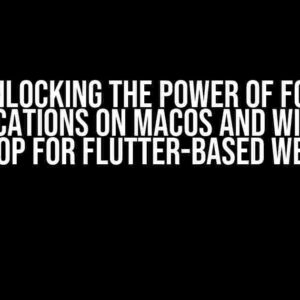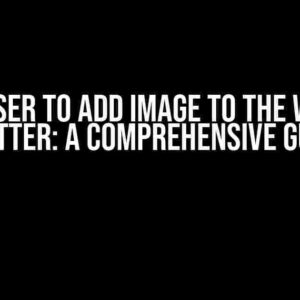Are you tired of low engagement and mediocre ad performance in your Flutter app? Look no further! In this comprehensive guide, we’ll walk you through the process of integrating Facebook real ads into your Flutter app, taking your user experience to the next level.
Why Facebook Ads?
With over 2.7 billion monthly active users, Facebook is the ultimate platform for reaching your target audience. By integrating Facebook ads into your Flutter app, you can:
- Boost user engagement and retention
- Increase revenue through targeted advertising
- Gain valuable insights into user behavior and demographics
Prerequisites
Before we dive into the integration process, make sure you have the following:
- A Facebook Developer Account
- A Facebook App ID and App Secret
- The Facebook SDK for Flutter installed in your project
- A basic understanding of Dart and Flutter development
Step 1: Create a Facebook App and Register for Facebook Ads
Head over to the Facebook Developer Portal and follow these steps:
1. Click on "Add New App" and enter your app's name and contact email. 2. Choose "App for Business" as the app type. 3. Click on "Create App" and navigate to the app's dashboard. 4. Click on "Get Started" under the Facebook Ads section. 5. Fill out the required information, including your app's name, description, and icon. 6. Click on "Submit" to register for Facebook Ads.
Step 2: Install the Facebook SDK for Flutter
Add the Facebook SDK to your Flutter project by running the following command in your terminal:
flutter pub add facebook_sdk
Then, import the Facebook SDK in your Dart file:
import 'package:facebook_sdk/facebook_sdk.dart';
Step 3: Initialize the Facebook SDK
Initialize the Facebook SDK by calling the `FacebookSdk.init()` method:
FacebookSdk.init(
appId: 'YOUR_APP_ID',
permissions: [
'public_profile',
'email',
],
);
Replace `YOUR_APP_ID` with your Facebook App ID.
Step 4: Load Facebook Ads
Load Facebook ads in your Flutter app using the `FacebookAudienceNetwork` class:
import 'package:facebook_audience_network/facebook_audience_network.dart'; FacebookAudienceNetwork.load( placementId: 'YOUR_PLACEMENT_ID', adType: AdType.banner, );
Replace `YOUR_PLACEMENT_ID` with your Facebook Ad Placement ID.
Step 5: Display Facebook Ads
Display Facebook ads in your Flutter app using the `FacebookBannerAd` widget:
FacebookBannerAd( placementId: 'YOUR_PLACEMENT_ID', adSize: rectangle, )
Replace `YOUR_PLACEMENT_ID` with your Facebook Ad Placement ID.
Step 6: Handle Ad Events
Handle ad events, such as ad loading, clicking, and closing, using the `FacebookAudienceNetwork` class:
FacebookAudienceNetwork.listener = (event) {
if (event.type == AdEventType.loaded) {
print('Ad loaded');
} else if (event.type == AdEventType.clicked) {
print('Ad clicked');
} else if (event.type == AdEventType.closed) {
print('Ad closed');
}
};
Optimizing Ad Performance
Optimize ad performance by:
| Optimization Technique | Description |
|---|---|
| Ad Placement | Place ads in high-visibility areas, such as the bottom of the screen or between content sections. |
| Ad Formatting | Use native ad formats, such as rewarded videos or interstitial ads, to enhance user experience. |
| Ad Targeting | Target specific demographics, interests, or behaviors to increase ad relevance and engagement. |
| Ad Rotation | Rotate ads regularly to prevent ad fatigue and maintain user engagement. |
Conclusion
By following these steps, you’ve successfully integrated Facebook real ads into your Flutter app. Remember to optimize ad performance regularly to ensure maximum engagement and revenue. Happy coding!
Stay ahead of the curve with the latest Facebook ads integration techniques and best practices. Join our community of developers and marketers to share knowledge and insights.
Happy integrating!
Copyright 2023 [Your Name/Company]. All rights reserved.
Frequently Asked Question
Get ready to elevate your Flutter app’s advertising game with Facebook real ads integration! Here are some frequently asked questions to get you started:
What is Facebook real ads integration, and why do I need it in my Flutter app?
Facebook real ads integration allows you to monetize your Flutter app with high-quality, engaging ads from Facebook’s vast ad network. By integrating Facebook ads, you can increase your app’s revenue, enhance user experience, and reach a broader audience. It’s a win-win!
How do I set up Facebook real ads integration in my Flutter app?
To set up Facebook real ads integration, you’ll need to create a Facebook Developer account, register your app, and get an App ID and App Secret. Then, add the Facebook Audience Network SDK to your Flutter project, and implement the ad formats that best suit your app’s design and user experience.
What types of ad formats are available with Facebook real ads integration?
Facebook offers a variety of ad formats that can be integrated into your Flutter app, including banner ads, interstitial ads, rewarded videos, and native ads. These formats can be customized to fit your app’s unique design and user experience, ensuring a seamless ad integration.
How can I optimize my Facebook ads in my Flutter app for better performance?
To optimize your Facebook ads, make sure to test different ad formats, placements, and targeting options to find the best combination for your app. You can also use Facebook’s analytics tools to track ad performance, and adjust your ad strategy accordingly. Additionally, implement ad mediation to ensure maximum ad fill rates and revenue.
Is Facebook real ads integration compatible with other ad networks in my Flutter app?
Yes, Facebook real ads integration can be used alongside other ad networks in your Flutter app. In fact, integrating multiple ad networks can help increase ad revenue and fill rates. Just make sure to follow Facebook’s policies and guidelines for ad mediation and reporting.




